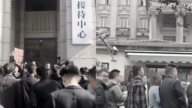【新唐人2011年12月13日訊】美國《洛杉磯時報》星期天(12月11日)在評論版發表了中國作家余華的文章。余華指出,當年中共黨魁毛澤東用於鼓動農民革命的「筷子理論」,正是這一代政府當下的難題。他說,中國的民眾就像一根根筷子,每根筷子勢單力薄,但「憤怒的筷子」集結起來就會爆發革命。學者們指出,無論是民主還是改革,一黨專政已經沒有出路。
余華在《中國之秋並非阿拉伯之春》(Chinese Autumn is no Arab Spring)文中說,毛澤東當年曾以「一根筷子易斷,一把筷子難折」的道理,鼓動農民和他一起鬧革命,一根筷子還是一把筷子,再次成為中國所面臨的問題。
余華說,目前「憤怒的筷子」遍佈全中國各地,每年爆發的群體抗爭事件數以萬計。據中國學者估算,僅去年一年,中國各地罷工、抗議事件就有18萬起,平均每天493起,比十年前增長了三倍以上。
武漢著名民主人士、中國民主黨創始人之一秦永敏:「要說從人數上,絕對人數上,反對這些侵犯人權做法的民眾,數量大大高於當局的這些人員。但是呢,當局幾十年來一直嚴禁中國人民結社,甚至對任何民眾自發的走到一起,它們都極為恐懼。」
出於對失去政權的恐懼,中共官方在「維穩」上撒的錢與「筷子們的憤怒」一同飆升。 中國憲政學者章立凡對《美國之音》形容,目前維穩在中國已經變成一個產業,地方和軍隊都希望通過「維穩」來多要錢,地方上甚至希望出現一些騷亂,通過鎮壓來博取政績。
突尼斯一個水果小販的自焚引發了「茉莉花革命」,進而引爆了席捲中東的「阿拉伯之春」。儘管中共官方不斷封鎖和扭曲這些民主革命推翻獨裁的消息,但人們一直在思考,目前中國各地的抗爭是否會引發「中國之春」?
美國喬治梅森大學教授章天亮:「各地在抗爭的時候,他們並沒有把結束中共的這個體製作為抗爭的主題,他們的抗爭都是一個具體的個案,比如說我這個地方環境污染啦,或者說我這個地方拆遷啦。當你在為一個利益訴求的話,中共一方面鐵腕鎮壓,另外一方面它可以暫時去滿足你這種利益訴求。但是很多人看不到,就是結束這個一黨專政,才是真正解決中國這些社會問題的原因。」
余華認為,目前擺在中國面前的只有兩條道路:民主或者革命。
美國喬治梅森大學教授章天亮博士:「其實余華講的這兩點,也就是說,中共一黨專政是沒有出路的。不管是民主還是革命,它的目地都是為了結束一黨專政。其實結束一黨專政已經成為民眾心中的一個願望,絕大多數的民眾心中都希望結束一黨專政,包括那些共產黨的官員們。」
而章立凡指出,中共高層間的爭鬥,地方執政者和北京之間的博弈,都將使改革的道路十分漫長而艱難,恐怕會陷入長期的僵局。他說,如果在十八大以後,新核心在他們的第一任期內不能夠啓動政治體制改革的話,也就不必啓動了,那就是只有等著最終被人民唾棄。
新唐人記者朱善智、尚燕、柏妮採訪報導。
Where do angry Chinese chopsticks point to?
The U.S. “Los Angeles Times” has published an article written
by Yu Hua, a Chinese author on Dec. 11.
In the article, Yu Hua has pointed out that Mao Zedong,
the former chairman of the Chinese Communist Party (CCP)
used the “chopsticks theory” to agitate for revolution,
which is a concern for the current government.
The “chopsticks theory” says the Chinese people are like
a bunch of chopsticks.
One chopstick is easy to snap, but the “Angry Chopsticks”
held together will be able to start a revolution.
Scholars have pointed out that no matter whether it will be
democracy or a revolution, there is no future for one-party dictatorship.
Yu Hua said in his article “The Chinese Autumn is no Arab
Spring” and that
Mao Zedong goaded Chinese farmers into rebellion by
spreading his theory:
one chopstick is easy to be snap, while a bunch of chopsticks
is impossible to break .
Now the “Chopsticks Theory “is once again in focus in China.
Yu Hua said, there’s “Angry Chopsticks” all over China, and
There are tens of thousands of fights annually in China.
According To the estimate of Chinese scholars, there were
180,000 strikes and protests in China last year, which shows an average of 493 events per day.
The amount of unrest is more than three times
that of ten years ago.
Qin Yongmin, a famous democrat in Wuhan city,
the co- founder of the Chinese democratic party said,
”The number of people that are against human rights violation
is much more than the number of officials in China.
However, the CCP regime prohibits, large gatherings,
and for people to get together spontaneously. The CCP is very scary.”
Because of the fear of losing power, the CCP spends a large
amount of money in maintaining stability,
but the anger of the “ Chopsticks “ is increased
at the same pace.
Zhang Lifan, a Chinese constitutional scholar told Voice of America,
that to maintain stability has become an industry in China.
Local government and the military use this reason as a ruse
to ask for more money from the central government.
Some local government s even anticipate unrest, as a means
by which they can achieve political qualification by consequent repression of the anticipated conflict.
In Tunisia, a fruit hawker’s self-immolation led to the
“Jasmine Revolution”, which swept the Middle East into the “Arab Spring” revolution.
Although the CCP regime blocked and distorted this news
for fear that a democratic revolution should topple the dictatorship in China,
but many Chinese have been wondering whether the unrest
all over China can lead to a “China Spring”?
Zhang Tianliang, a professor from George Mason University
says: “The Chinese don’t have as a target the end of the CCP’s dictatorship when they fight.
Their fights are dedicated to their special needs,
such as like pollution, demolition of property , etc.
When you fight for one reason, the CCP suppresses this with
an iron fist but will meet some of your needs at the same time.
Many Chinese don’t realize that to end the one-party dictatorship,
the real solution is to solve all the social problems in China.”
Yu Hua thinks that there are only two ways ahead for China:
either democracy or revolution.
Zhang Tianliang, a professor from George Mason University
says: “With the two solutions that Yu Hua mentioned there’s no way either can happen with the CCP in power.
No matter whether it’s to be democracy or revolution,
the purpose is the same, which is to end the dictatorship.
In fact, to end the CCP’s dictatorship
is a wish of the Chinese people.
Most Chinese wish to end the one-party dictatorship,
and this includes CCP officials.”
Zhang Lifan, a Chinese constitutional scholar said, the fighting
among CCP senior officials, between local governor and central rulers,
will make the road to reform difficult and long, and may also
lead the political system into a long-term deadlock.
He said that the new core-leading group that will be in
power after the 18th congress must start political reform
in their first term, otherwise expect to be abandoned
by the people.
NTD Reporters: Zhu Zhishan, Shang Yan and Bo Ni




























